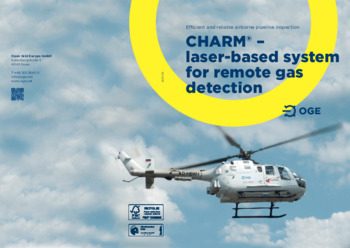
Safety
The faster way to find pipeline leaks. And it works like a CHARM®.
Detecting leaks in gas pipelines previously required walking along the pipeline with hand-held gas detection devices. This laborious process can be substituted by CHARM to a great extent. CHARM® is a laser-based system integrated into a helicopter that flies along the pipeline while the system scans the pipeline corridor and identifies even the tiniest gas leaks.

The charming name stands for “CH4 Airborne Remote Monitoring”, i.e. the remote detection of methane from the air. The system’s high degree of sensitivity means even very low methane concentrations can be pinpointed precisely from above. Even where pipeline topologies are very complex, the laser in the CHARM® system can detect the course of the pipeline consistently during the flight, with the result being highly reliable leak tightness inspections of gas pipelines.
And it’s not only for our own pipeline network that we use CHARM®: You too can make use of this inspection process for your pipelines Europe-wide. Right now, there is probably no more efficient or flexible method for above-ground leak tightness testing of natural gas pipeline networks.
Site level leak detection and quantification
In addition to leak tightness inspections, CHARM® has also turned out to be a suitable tool for methane emissions quantification at compressor stations, storage facilities and other natural gas infrastructure installations. The location of a gas release as well as its release rate can both be determined here. The whole area of a site is completely covered with laser spots, every single leak point is detected, natural gas plumes are visualized, and methane emission rates are calculated with the support of wind data that is measured simultaneously. Detailed information can be found in a research report by the European Gas Research Group.
Service features at a glance:
- Helicopter-borne remote gas detection system using an infrared laser
- Reliable detection of the slightest traces of natural gas (at altitudes of 80 m to 140 m)
- Operational leak detection limit of 20 l/h, depending on wind conditions
- Recognised process in accordance with the DVGW codes (Guideline G 501 "Airborne remote gas detection methods")
- High level of geographical accuracy thanks to the automatic tracking of the pipeline route (CHARM® auto tracking – CAT)
- Automatic documentation of the pipeline inspection and notification of unusual occurrences in real time
- Safe and reliable pipeline monitoring in built-up areas (conurbations) and outside developed areas guaranteed
- Extensive data analysis and prioritisation of the recorded results complete with recommended actions for the client
- Auditing-compliant documentation with geo-referenced measurement points and detailed aerial photos
- Optional data management tools and IT applications for on-site inspections
- Airborne survey and scanning of complete areas including leak detection and quantification
- Detection limit for above-ground leakages of 50 l/h
- Emissions quantification for leak rates over 500 l/h
- Optional on-site wind measurement for precise emissions calculation with small variation limits.
CHARM® in detail
Above-ground leak tightness tests on high-pressure gas pipelines using our aerial remote gas detection system are more than just a flyover. Our service includes:
- Price quote and data provision
- Flight planning and preparations
- Systematic safety review for airborne surveys above gas infrastructure sites, e.g. flights close to hazardous areas
- Above-ground pipeline inspection to detect any leaks
- Evaluation and preparation of the measurement values and classification of non-relevant gas indications arising from methane drifts from other sources as well as emissions quantification
We also offer you photo tiles and associated geo-information. If required, we can provide an online GIS application that allows you to visualise, process and store the CHARM® results and compare them with previous reports.
Unique features:
CHARM® is a state-of-the-art system for remote gas detection. It works more reliably than any other remote gas detection process.
- Automatic scan beam control with precision better than 0.5 m
- Official authorisation from the German Aviation Authority (Luftfahrbundesamt – LBA) / European Aviation Safety Agency (EASA) and DVGW certification in accordance with information sheet G 501
- Continuous recording of all data from each individual laser pulse provides a high level of measuring precision (operational detection level from 5 ppm·m at 120 m altitude) and ensures system is audit-proof
- Immediate analysis by on-board preliminary evaluation tool and automatic notification of the CHARM® team (as necessary)
- Combined leak detection for pipelines plus emissions detections and quantification at sites close to pipeline track
- Reliable post-processing thanks to many years of experience, differentiation between real releases and methane drifts from other sources and thus avoidance of unnecessary on-site inspections
- Online GIS permits easy access to the results and archives the data
How CHARM® works
How CHARM® works
The CHARM® measuring process is based on the absorption of infrared light by methane as a main component of natural gas. CHARM® generates two laser pulses of different wavelengths. The first pulse has the measurement wavelength (λon) and is absorbed by methane, while the second pulse follows with a reference wavelength (λoff) and is not absorbed.
Both light signals are sent out virtually at the same time as a double pulse from the helicopter to the ground, where the light is scattered in all directions. Part of the backscattered light is recaptured by the measurement system. The ratio of both backscatter intensities makes it possible to calculate the gas concentration in ppm·m (parts per million · meter).
The measurement signal is an integrated concentration value across the full length of the light path between the ground and the helicopter and is measured in the unit ppm·m. If, for example, there is a thin layer of gas on the surface with an average concentration of 550 ppm and a height of 5 cm, this results in an integrated concentration value of 25 ppm·m, which is reliably detected by CHARM®.
This measuring principle is known as Differential Absorption LIDAR (DIAL). LIDAR stands for “Light Detection And Ranging”.
In order to reliably capture the smallest traces of natural gas, it is nevertheless just as important to position the laser light pulses precisely along the pipeline route. The helicopter uses differential GPS to determine its precise position. In combination with an inertial measuring system (IMS) for determining the position in a three-dimensional space, the flight movement of the helicopter is calculated up to two seconds in advance. Comparison of the geo-referenced pipeline coordinates then makes it possible to target the pipeline route precisely. A rotating tracking head compensates for the influences of the helicopter movement and automatically directs the measuring beam precisely on the centreline of the pipeline.
CHARM® sends 1,000 double laser pulses per second to the ground. At a standard altitude of 120 m the measuring points on the ground have a diameter of around 1 m. Furthermore, a scanner scatters the laser pulses across a wide corridor of the pipeline route to a width of at least 7 m. The high number of laser pulses permits flight speeds of up to 90 kn (approx. 170 km/h) for quick and efficient tightness inspections.
FAQs
The laser-based gas detection system CHARM® from OGE is the innovative solution for above-ground inspection of the tightness of natural gas transmission networks. Natural gas pipelines previously had to be inspected for leak tightness from the ground, but modern remote surveying technology offers new possibilities. We utilise this potential with CHARM®.
CHARM® is used to check the leak tightness of natural gas pipelines in built-up and rural areas. The highly sensitive system and the automated scanning beam control system (autotracking) allow CHARM® to be used reliably even on complex pipeline topologies such as those in urban areas.
Furthermore, CHARM® can be used for leak inspection of complete sites including emissions quantification.
Natural gas pipelines allow the safe, fast and economic transmission of large energy volumes. Stringent safety requirements for operation and the material used, as well as regular, extensive inspections and checks during operation with state-of-the-art technology ensure the high safety standards of these pipeline systems. CHARM® is a good example of this.
The entire network of the OGE is regularly checked completely with CHARM®. We also monitor our pipelines and the surrounding area in a two-weekly rhythm in a visual surveying flight totally independent of CHARM®.
Along with pipeline surveys, OGE’s compressor stations and other gas infrastructure sites are inspected using CHARM®, too. If there are any gas releases, these are identified and quantified and emissions shut off immediately.
The CHARM® crew comprises the pilot and one CHARM® operator. There are currently four pilots and eight CHARM® operators who take it in turns on the helicopter. There are also a number of ground staff involved in flight preparation and scheduling, data processing and analysis, and evaluation of the results.
The laser does not pose a danger to either humans or animals. Due to the target’s distance, the light spot is actually scattered to the extent that its diameter on the ground is roughly one metre. Furthermore, there are no optical instruments at that frequency range of light that are able to focus the laser beam enough for it to be harmful. Additional automated safety mechanisms ensure that no laser light is emitted when the helicopter flies below an altitude of 60 m.
Are you interested in our products and services?




